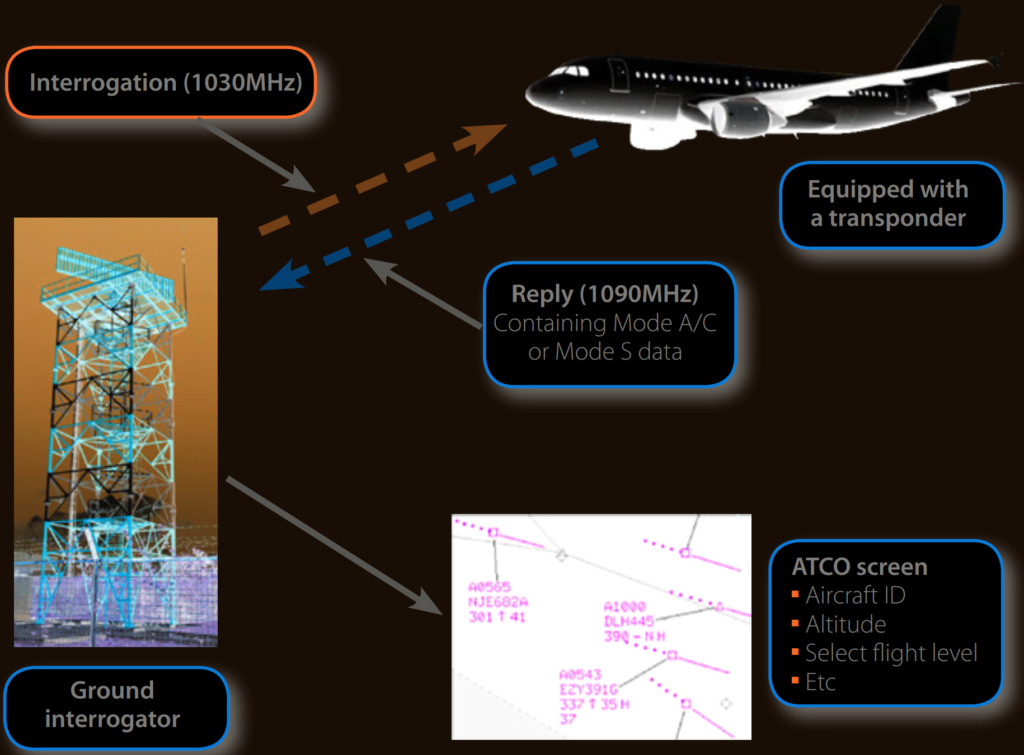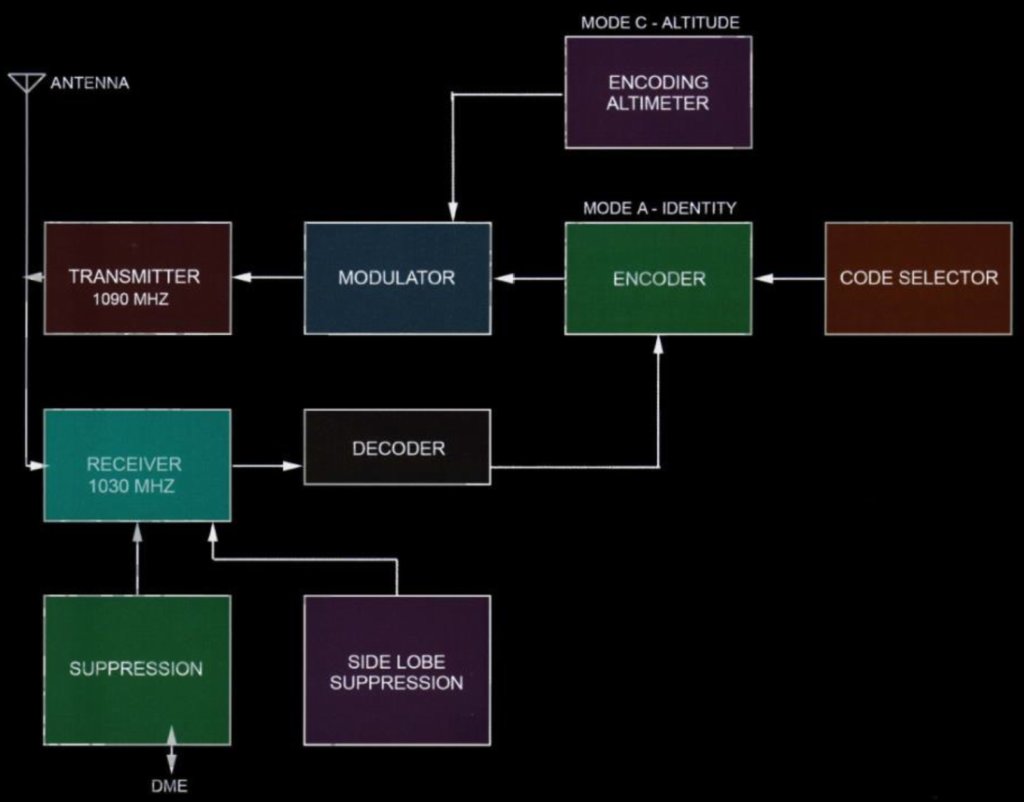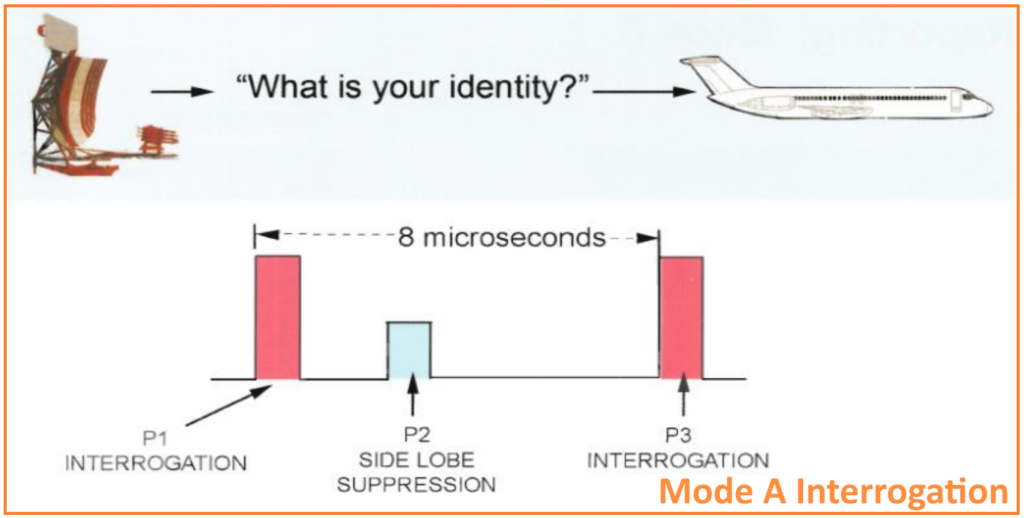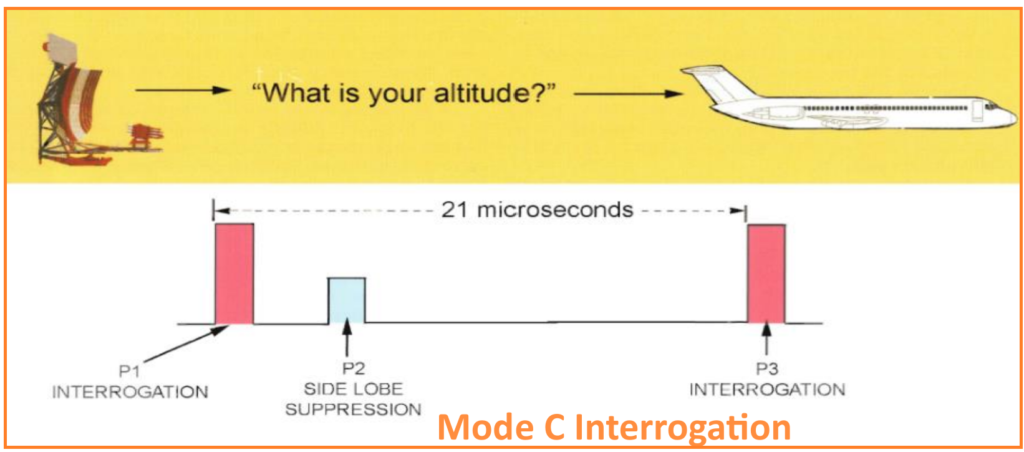Transponders are important devices used in aviation for communication and identification purposes. Transponders are electronic devices installed in aircraft that respond to radio signals from ground-based radar systems and other aircraft. They work by receiving a signal from a radar facility on the ground or from another aircraft, and then transmitting a coded response signal back to the radar system.
The transponder’s coded response includes information such as the aircraft’s identity (typically its unique 4-digit code known as a “squawk code”), altitude, and other flight data. This information helps air traffic controllers identify and track the aircraft’s position, altitude, and heading, enhancing safety and efficiency in the airspace.
What is Transponder?
Transponders are avionic systems installed on aircraft that transmit information such as aircraft identification and barometric altitude to ground-based air traffic control (ATC) systems and Traffic Collision Avoidance Systems (TCAS) on other aircraft. They respond to interrogation signals from systems like secondary surveillance radar (SSR) or multilateration systems. In addition, ADS-B capable transponder in aviation enable aircraft to broadcast information to ground stations and other aircraft without requiring interrogation. Transponders are not exclusive to commercial aircraft; they are also used in helicopters, military aircraft, general aviation, gliders, unmanned aerial systems (UAS), and some airside ground vehicles.
How do transponders work?
Transponder in aviation operations in aviation follow standardized procedures outlined in ICAO Annex 10 Volume IV.

Here’s how it works:
Interrogation: The process begins with the ground interrogator, or in the case of TCAS (Traffic Collision Avoidance System), the airborne interrogator, transmitting an interrogation sequence on the frequency of 1030MHz. This transmission is either continuous to all aircraft in the vicinity for Mode A/C or selective to a single aircraft for Mode S.
Transponder Response: Upon receiving the interrogation signal, the transponder installed onboard the aircraft immediately responds by transmitting a coded signal on the frequency of 1090MHz. This response includes vital information such as the aircraft’s identification code (squawk code), altitude, and other flight data.
Data Processing: Once the ground station receives the return signal from the aircraft’s transponder in aviation, the transmitted data is processed and relayed to the air traffic controller’s display or used by various tools and safety nets. This information allows controllers to track the aircraft’s position, altitude, and movement accurately.
By following these standardized procedures, transponders facilitate effective communication and identification between aircraft and ground-based systems, enhancing safety and efficiency in air traffic management.
Transponder Block Diagram.
Here’s a block diagram of a transponder system:

- Receiver: Receives interrogations from ground stations at 1030 MHz.
- Decoder: Measures incoming pulses and identifies them; recognized pulses are sent to the encoder.
- Encoder: Generates the pulsed reply based on the received interrogations.
- Encoding Altimeter: Converts barometric pressure to a signal for a Mode C reply, indicating altitude information.
- Code Selector: Allows the pilot to dial in the assigned transponder code provided by air traffic control (ATC).
- Modulator: Amplifies pulses forming the reply and sends it to the transmitter for transmission at 1090 MHz.
- Transmitter: Transmits the reply signal to ground stations and other aircraft.
- Side Lobe Suppressor: Filters out side lobe signals to prevent false position information on ATC radar scopes.
- Suppression Circuit: Prevents interference from Distance Measuring Equipment (DME) signals, which also use pulsed transmissions.
This diagram outlines the key components and functions of a transponder system, illustrating how it receives, processes, and transmits signals for communication with ground stations and other aircraft.
Transponders Role in Surveillance and Collision.
Transponders play a crucial role in aviation by providing air traffic controllers with essential information for surveillance and collision avoidance. Here are some key uses of transponders in aviation:
- Enhanced Surveillance: Transponder signals provide controllers with more detailed surveillance information compared to primary radar, including accurate barometric altitude readings directly from the aircraft’s transponder.
- Aircraft Identification: Transponders transmit identification information that helps correlate aircraft tracks with their flight plans, aiding in air traffic management and coordination.
- Controller Tools: Identification information from transponders can be used by controller tools such as Arrival Manager (AMAN), Medium-Term Conflict Detection (MTCD), and conformance monitoring tools to enhance airspace management and safety.
- Downlink Airborne Parameters (DAPs): Mode S transponders can downlink additional aircraft parameters such as selected altitude, enabling ATC systems to monitor altitude clearance and improve safety alerting performance.
- Traffic Collision Avoidance System (TCAS): TCAS relies on transponder signals to detect potential conflicts between aircraft and provide Traffic Advisories (TAs) and Resolution Advisories (RAs) to pilots. Mode S transponders facilitate coordinated RAs between equipped aircraft, reducing the risk of collision.
Overall, transponders contribute significantly to air traffic management and safety by providing accurate surveillance data and enabling effective collision avoidance measures.
Different Modes of Transponder.
In civil aviation, two main interrogation-reply modes are used: Mode A/C and Mode S. Here’s an overview of each mode:
1. Mode A/C.
- Mode A: In response to Mode A interrogations, the transponder in aviation transmits an identity code for the aircraft in the octal range 0000-7777. Some codes are allocated to transmit specific emergency situations.
- Mode C: Provides the aircraft’s barometric altitude in 100 feet increments. Mode A/C operation has several limitations, including inefficient use of the radio spectrum and a limited number of Mode A codes available.


2. Mode S.
- Developed to overcome the limitations of Mode A/C, Mode S offers several advancements:
- Over 17 million unique 24-bit aircraft addresses.
- Altitude reports in 25 feet increments.
- Selective interrogation: Mode S stations can make selective interrogations of specific aircraft, reducing unnecessary transmissions and improving efficiency.
- ‘All call’ interrogations: Used to identify new aircraft for interrogation.
- Ability to transmit Downlink Airborne Parameters (DAPs), providing additional aircraft parameters.
Overall, Mode S offers significant improvements over Mode A/C in terms of address capacity, altitude reporting, and selective interrogation, making it a more efficient and versatile mode for air traffic surveillance.
Deployment and carriage requirements.
The deployment and carriage requirements for Mode S transponders and secondary surveillance radar (SSR) systems have evolved over time, especially with the transition from Mode A/C to Mode S technology. Here are the key points:
Deployment of Mode S SSR Systems.
- Many SSR Mode S systems are already deployed and operational across the core European area and beyond.
- In Europe, these systems comprise a mix of Elementary and Enhanced Surveillance capabilities.
Mandatory Equipage of Mode S Transponders.
- Mode S transponder equipage is now mandatory for:
- Flights conducted under Instrument Flight Rules (IFR)/General Air Traffic (GAT) in many European states.
- Visual Flight Rules (VFR) flights in some designated airspace.
- Local mandates in European states have been supplemented by European-wide regulations.
Compliance Deadlines.
- European regulations mandate compliance with Mode S Elementary Surveillance by January 2015 for existing aircraft and December 2017 for new and retrofit aircraft.
- Aircraft with a minimum take-off mass greater than 5,700 kg and/or with a maximum cruising true airspeed greater than 250 knots must be compliant with Mode S Enhanced Surveillance (EHS) within the same timescales.
- Compliance with EHS requires the carriage and operation of an extended squitter transponder in aviation, fulfilling “ADS-B Out” requirements for both ground and airborne surveillance applications.
Future Discussions.
- There are ongoing discussions about extending the applicability of EHS to increase opportunities for rationalization of surveillance infrastructure on the ground.
Overall, the shift towards Mode S technology and the associated regulations aim to enhance air traffic surveillance capabilities, improve safety, and facilitate more efficient air traffic management in European airspace.
The future of Transponder.
In the future, several initiatives are expected to further rely on transponders for various purposes. Here are some key points regarding the future of transponder usage:
- Increased Use of ADS-B:
- Automatic Dependent Surveillance-Broadcast (ADS-B) technology is expected to play a larger role in surveillance, especially in low-density and remote regions.
- ADS-B systems may be utilized for oceanic surveillance, potentially through transponders broadcasting data to satellite-based ADS-B receivers.
- Expansion of Transponder-Equipped Aircraft:
- Efforts are underway to increase the number of aircraft equipped with transponders.
- This may involve the development and deployment of low-power, low-cost transponders suitable for various aircraft types, including gliders.
Overall, the future of transponder technology involves leveraging advancements like ADS-B to enhance surveillance capabilities in diverse operational environments and to expand the accessibility of transponder-equipped aircraft across different segments of aviation.
Frequently Asked Questions.
What occurs when a transponder experiences a failure?
How frequent is total transponder failure?
Isn’t there a backup transponder on the aircraft, and is the crew alerted in case of a failure?
In the event of a transponder failure, there may be a warning given to the crew, but it may not always be prominent and could go unnoticed. In some cases, there may be no warning at all. For instance, in 2006, an Embraer business jet and a Boeing 737 were both flying at the same altitude over Brazil. The transponder on the Embraer had stopped working, unbeknownst to the crew.
As the Traffic Collision Avoidance System (TCAS) relies on transponder signals to function, the Embraer’s TCAS did not detect the Boeing 737, and vice versa. Tragically, this led to a collision between the two aircraft. This example underscores the importance of maintaining and monitoring transponder functionality and highlights the potential consequences of transponder failures in aviation.
What effects does a complete loss of transponder have on the controller?
They may have to rely more on verbal communication with pilots and procedural control methods. This means they have limited ability to give real-time instructions, including those for avoiding collisions. Even if primary radar is present, controllers still lose altitude and possibly identity information, leading to additional challenges and workload impacts.
Does the controller receive a warning when all information about an aircraft disappears? If not, how do they detect the loss of information?
In cases where there’s no automated alert, it’s up to the controller to detect the loss of information through situational awareness. They may regularly scan their radar screens or notice the absence of an aircraft during sector handovers when the aircraft contacts ATC but isn’t visible on the screen.
Detecting total transponder in aviation failures can be easier when there’s only one aircraft in the sector, but it can be more challenging when multiple aircraft are present. This means that total failures may sometimes go unnoticed for a period, which can have critical consequences. As a result, transponder failures are considered one of the Top 5 ATM Operational Safety Priorities.
Upon detection of a transponder failure, what actions does a controller take, and are there standardized procedures in place for handling such situations?
When primary radar isn’t available, controllers have several options. These can include relying on pilots to report their positions verbally, allowing controllers to guide them using procedural control methods. In more serious situations, such as when there’s a risk to safety, measures like military escort or even refusing entry to the next airspace section may be considered. In extreme cases, controllers may direct the aircraft to return to its departure airfield or the nearest suitable airport. Additionally, to ensure safety, the affected aircraft should be directed out of Reduced Vertical Separation Minima (RVSM) airspace and kept clear of other aircraft.
Is flight plan data a viable alternative option?
However, some systems can continue to display a track associated with a flight plan even if radar contact is lost before reaching the end point of the flight plan. This helps provide some increased awareness to the controller. The color or symbol of the track may change to indicate that there is no radar data behind it, serving as a warning to the controller that radar data has been lost.
It’s important to note that the accuracy of the position information derived from flight plan data decreases over time and may require manual adjustment based on reports from the pilot. Therefore, while flight plan data can provide some assistance in maintaining awareness, it is not as reliable as radar data and requires additional attention and verification.
How will the functionality of controller tools and the effectiveness of STCA and TCAS be impacted?
Controller Tools: Tools that rely on real-time transponder information, such as conformance or adherence monitoring tools, may not operate at all or become less reliable. These tools help controllers monitor aircraft positions and ensure adherence to flight paths or separation standards.
Safety Nets (STCA and TCAS): Safety nets such as Short-Term Conflict Alert (STCA) and Traffic Collision Avoidance System (TCAS) rely on transponder replies to detect potential conflicts between aircraft and provide alerts to pilots and controllers. Without an active transponder, an aircraft effectively becomes invisible to these safety nets, reducing their effectiveness in preventing mid-air collisions or conflicts.
In essence, the absence of transponder-based information significantly impacts the functionality and reliability of controller tools and safety nets, potentially compromising the overall safety and efficiency of air traffic management. This underscores the importance of maintaining transponder functionality and implementing contingency measures to mitigate the impact of transponder failures on air traffic operations.